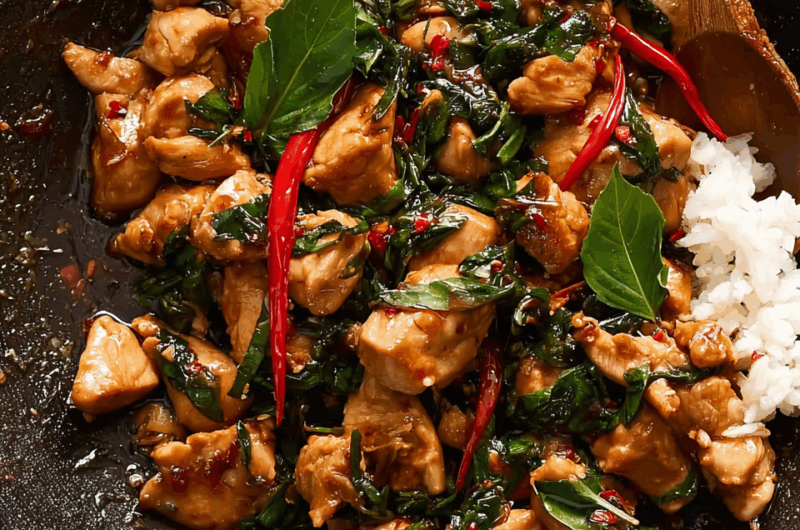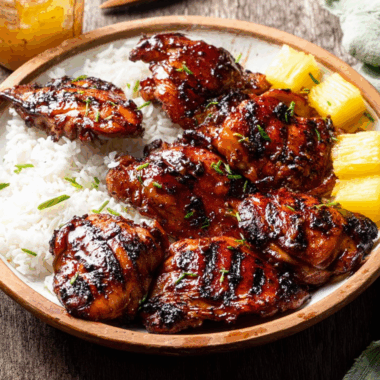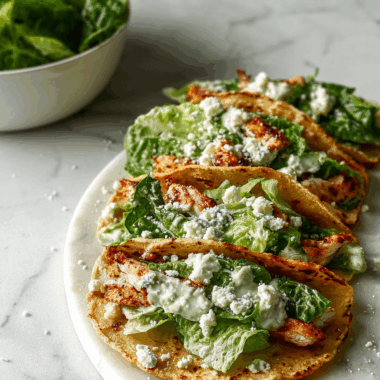The fragrant, fiery flavors of Thai Basil Chicken make it a standout dish for weeknight dinners or spontaneous cravings. This classic stir-fry, known as Pad Krapow Gai in Thailand, balances heat, savoriness, and herbal brightness thanks to the fresh Thai basil and red chilies. Served with a warm bowl of jasmine rice, it’s the ultimate comfort food for spice lovers. What makes this dish even better? It’s ready in just 20 minutes! No need for complicated techniques or hard-to-find ingredients. Just simple, bold flavors cooked fast in one pan. Whether you’re a Thai cuisine enthusiast or a curious home cook, this recipe delivers restaurant-quality results from your own kitchen.
Full recipe:
Ingredients:
-
1 lb ground chicken
-
1 tablespoon vegetable oil
-
4 cloves garlic, minced
-
2 shallots, finely chopped
-
2 Thai red chilies, sliced (adjust to taste)
-
2 tablespoons soy sauce
-
1 tablespoon oyster sauce
-
1 tablespoon fish sauce
-
1 teaspoon sugar
-
1/4 cup water
-
1 cup Thai basil leaves, loosely packed
-
Cooked jasmine rice, for serving
Directions:
-
Heat vegetable oil in a large skillet or wok over medium-high heat.
-
Add garlic and shallots, sauté until fragrant (about 1 minute).
-
Stir in Thai red chilies and cook for another 30 seconds.
-
Add ground chicken and break it up with a spatula, cooking until browned and cooked through, about 5–7 minutes.
-
Pour in soy sauce, oyster sauce, fish sauce, sugar, and water. Stir to combine and cook for another 2 minutes to let the flavors meld.
-
Remove from heat and stir in the Thai basil leaves until wilted.
-
Serve hot over steamed jasmine rice.
Prep Time: 10 minutes | Cooking Time: 10 minutes | Total Time: 20 minutes
Kcal: 310 kcal | Servings: 4 servings
The Irresistible Allure of Thai Basil Chicken
Thai Basil Chicken, known locally in Thailand as Pad Krapow Gai, is one of the most popular and beloved street foods in Thai cuisine. It’s a dish that captures the essence of what makes Thai food so addictive: a perfect balance of spicy heat, sweet undertones, salty depth, and fresh herbal brightness. This classic stir-fry recipe is simple, fast, and bursting with flavor, making it a favorite for home cooks around the world.
In this article, we’ll dive into the origins of this beloved dish, explore the key ingredients that make it so special, discuss its health benefits, and share practical cooking tips that guarantee you’ll master it in your own kitchen. Whether you’re a seasoned Thai food lover or just dipping your toe into Southeast Asian cooking, Thai Basil Chicken is the perfect recipe to start with.
Origin and Cultural Significance of Thai Basil Chicken
Thai Basil Chicken holds deep cultural significance in Thailand. It’s more than just a quick meal; it’s a symbol of comfort, tradition, and national pride. You’ll find it served everywhere—from bustling Bangkok street vendors to humble family kitchens and high-end restaurants.
The name Pad Krapow Gai breaks down as follows: Pad means stir-fry, Krapow refers to holy basil (a different variety from Italian basil), and Gai means chicken. Holy basil is considered sacred in Thai and Indian cultures, often used in religious rituals as well as in culinary traditions. The herb’s peppery, slightly spicy flavor adds a unique depth that distinguishes this dish from other stir-fries.
Often served with a fried egg (kai dao) on top, this meal is a staple of the Thai lunch crowd. Office workers, students, and travelers alike seek it out for its bold taste and quick preparation time. In Thailand, it’s often the go-to order when someone doesn’t know what to eat but wants something deeply satisfying.
Why Thai Basil Chicken Is So Popular
One reason this dish is universally loved is its simplicity. It requires minimal ingredients, most of which are pantry staples or easily found in supermarkets. The magic lies in the combination of sweet, salty, spicy, and savory components—all infused into tender ground chicken and served hot over fluffy jasmine rice.
Unlike many other Thai recipes that require curry pastes or simmering sauces, Thai Basil Chicken comes together in just one pan and in under 20 minutes. It’s approachable for beginners but impressive enough to serve to guests.
Furthermore, its versatility makes it incredibly appealing. Don’t eat chicken? Swap it with ground turkey, tofu, pork, or even beef. Want to add veggies? Throw in bell peppers, green beans, or bok choy. Looking to go low-carb? Serve it in lettuce cups or over cauliflower rice.
The Secret Ingredient: Thai Holy Basil
The heart and soul of this dish is Thai holy basil. This variety of basil differs from the sweet Italian basil commonly used in Western cuisine. Holy basil (or krapow in Thai) has jagged edges and a slightly spicy, clove-like flavor that intensifies when cooked.
If you can’t find holy basil, Thai basil (with its anise-like flavor) is an acceptable substitute, though it does shift the flavor slightly. Italian basil should only be used as a last resort, as it lacks the punchy aroma and taste that define the dish.
Including fresh holy basil elevates the authenticity of the meal. It not only provides a peppery bite and herbal fragrance but also offers several health benefits (which we’ll explore shortly).
Health Benefits of Thai Basil Chicken
While Thai Basil Chicken is known for its flavor, it also packs a surprising number of health benefits:
-
High in Protein: Ground chicken is a lean protein that supports muscle development, satiety, and overall metabolism.
-
Rich in Antioxidants: Holy basil contains compounds like eugenol, rosmarinic acid, and flavonoids that fight oxidative stress and inflammation.
-
Anti-bacterial and Anti-inflammatory Properties: Holy basil is used in Ayurvedic medicine for its healing effects and is believed to support immune health and reduce stress.
-
Low in Carbs (if served without rice): The stir-fry itself is low in carbohydrates, making it suitable for low-carb or keto diets when served with alternatives like cauliflower rice or lettuce wraps.
-
Quick Cooking Retains Nutrients: Since the dish is cooked at high heat for a short period, more nutrients are preserved in the ingredients compared to long-cooking methods.
Overall, Thai Basil Chicken can be part of a nutritious diet when portioned well and paired with whole grains or vegetables.
Flavor Profile and Texture
The flavor of Thai Basil Chicken is bold and complex. It brings together:
-
Savory umami from soy sauce, oyster sauce, and fish sauce
-
Heat from fresh red Thai chilies (which you can adjust based on your spice tolerance)
-
A touch of sweetness from sugar to balance the spice
-
Herbal freshness from holy basil
-
Garlic and shallots which create the foundational aroma
The ground chicken soaks up all the sauces and spices, resulting in tender, juicy bites that burst with flavor. The crispy fried egg served on top adds texture and richness, while the fluffy jasmine rice balances the heat and saltiness of the dish.
How to Make It Perfectly Every Time
Mastering Thai Basil Chicken is all about timing and heat. Here are a few expert tips to ensure your dish turns out restaurant-quality:
-
Prep Before You Cook: Since stir-frying is a fast process, have all your ingredients chopped and sauces mixed before you turn on the stove.
-
Use a Wok or Wide Skillet: High heat and quick cooking are essential. A wok distributes heat evenly and adds a slight smoky flavor known as wok hei.
-
Don’t Overcook the Basil: Add basil at the very end and stir only until wilted. Overcooking it can make the leaves bitter and dull.
-
Adjust Spice: Thai chilies are potent. If you’re sensitive to spice, remove the seeds or substitute with milder peppers like jalapeños or Fresno chilies.
-
Fry an Egg: A crispy, golden-edged fried egg with a runny yolk adds richness and balances the spicy and salty notes perfectly.
Variations and Serving Ideas
Thai Basil Chicken is incredibly adaptable. Here are a few popular variations:
-
Vegetarian: Replace chicken with firm tofu or tempeh. Use soy-based fish sauce alternatives.
-
Low-Carb: Serve over cauliflower rice or in lettuce cups.
-
With Veggies: Add green beans, onions, red bell peppers, or zucchini for added nutrition and crunch.
-
Noodle Bowl: Instead of rice, serve the stir-fry over rice noodles or glass noodles for a twist.
Pair the dish with a light soup, Thai iced tea, or a fresh papaya salad to create a complete Thai meal experience.
Why You’ll Keep Coming Back to This Recipe
People love Thai Basil Chicken because it hits all the right notes: it’s fast, flavorful, flexible, and incredibly satisfying. It’s a one-pan meal that feels like a culinary adventure. There’s no need for fancy ingredients or advanced skills, making it perfect for weeknight dinners and meal preps.
For those new to Thai cooking, it serves as a great introduction without being intimidating. For seasoned cooks, it’s a recipe you’ll return to when you crave bold flavors in a flash.
Conclusion
Thai Basil Chicken is more than just a quick stir-fry; it’s a celebration of Thai culinary balance and simplicity. From its cultural roots in Bangkok street food stalls to its adaptable nature in home kitchens worldwide, this dish has rightfully earned its place among global comfort food favorites. It’s healthy, packed with flavor, easy to make, and endlessly customizable. Whether you’re in a rush or planning a flavorful feast, Thai Basil Chicken is a guaranteed winner. Try it once, and it just might become your new go-to meal.








